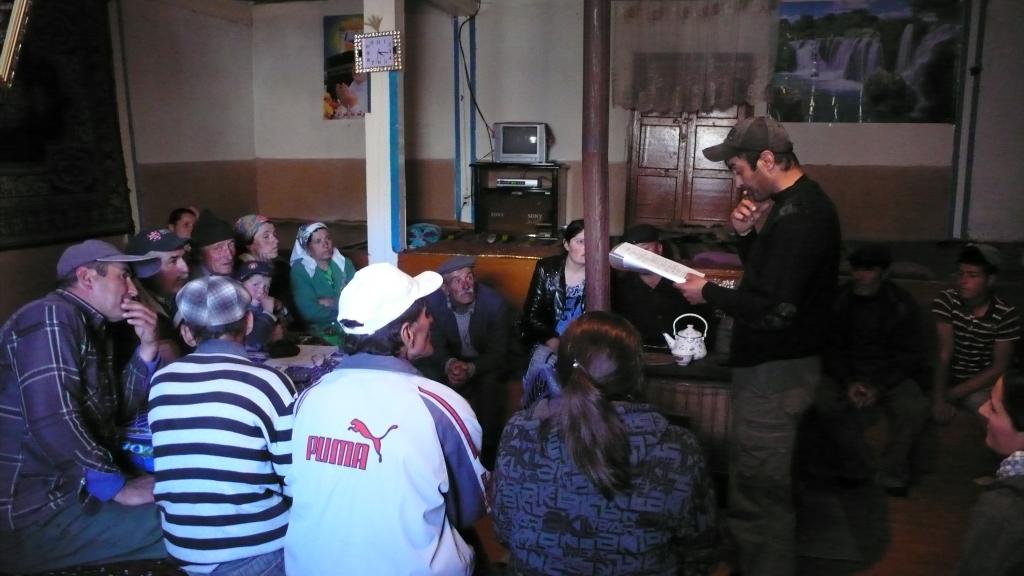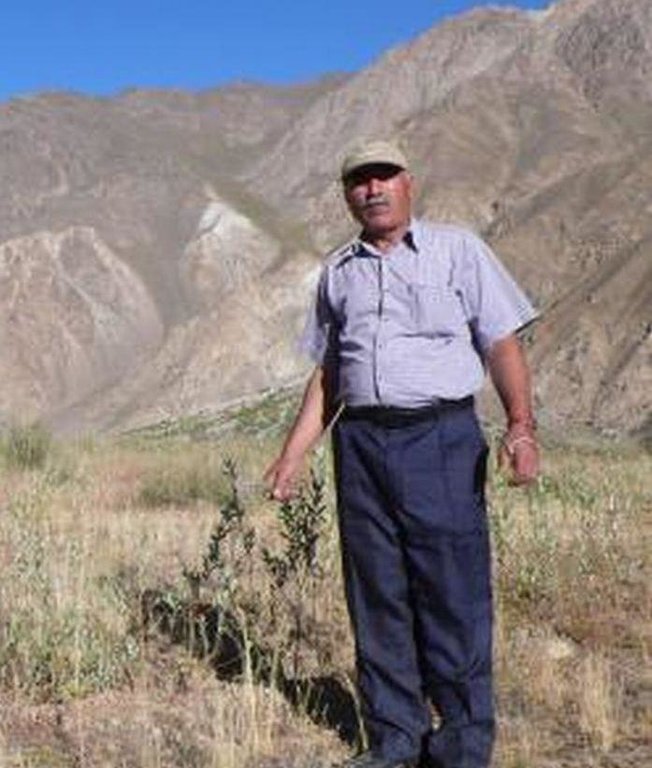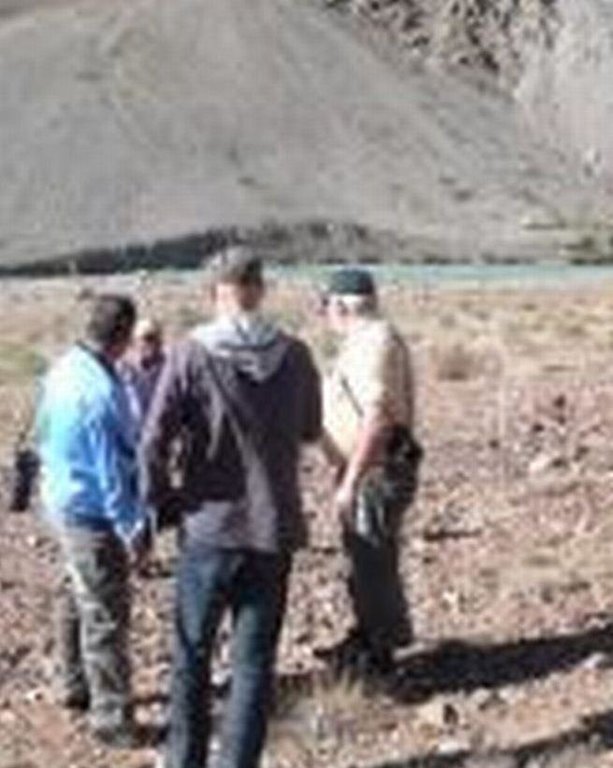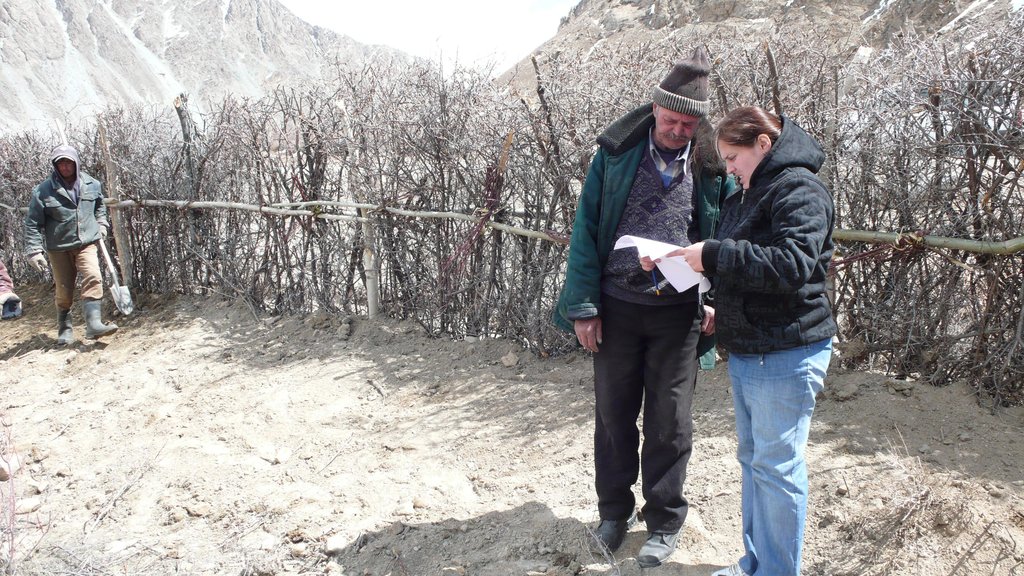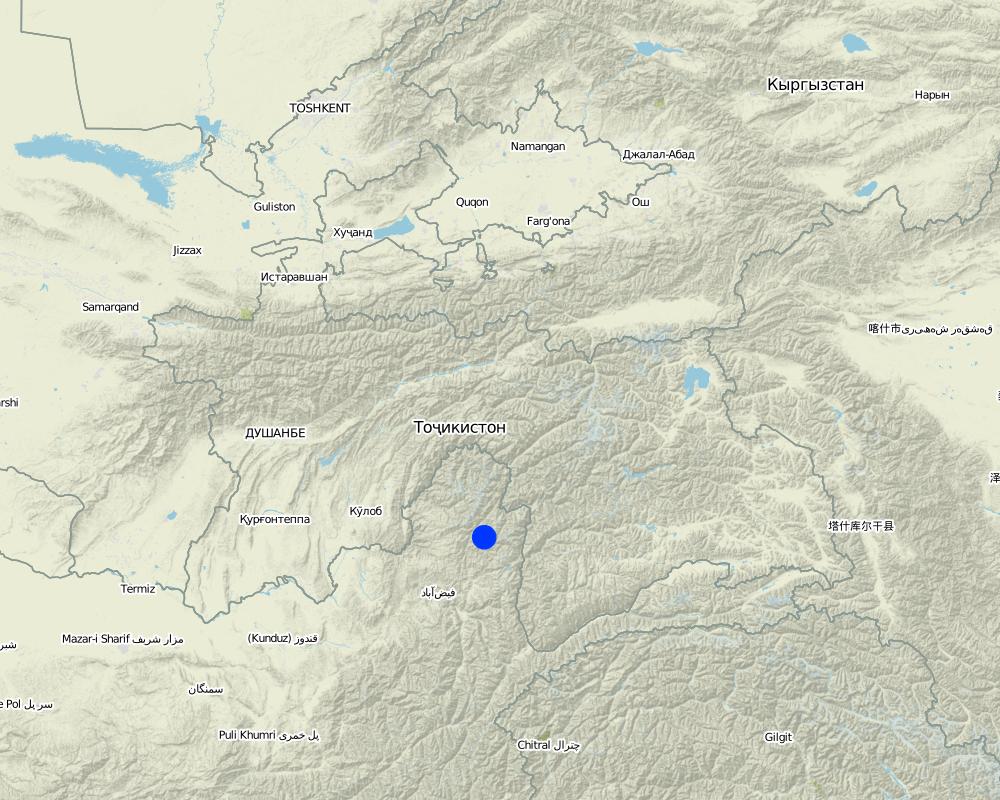Savings Book Approach [Tayikistán]
- Creación:
- Actualización:
- Compilador: Roziya Kirgizbekova
- Editor: –
- Revisor: David Streiff
Sberegatelnaya knizhka (Russian)
approaches_2445 - Tayikistán
Visualizar secciones
Expandir todo Colapsar todos1. Información general
1.2 Detalles de contacto de las personas de referencia e instituciones involucradas en la evaluación y la documentación del Enfoque
Especialista MST:
Neusel Benjamin
benjamin.neusel@cimonline.de
GIZ
Sustainable Management of Natural Resources in Gorno-Badakhshan, Okhonjon Str. 58-1, 736000 Khorog
Alemania
Especialista MST:
Kirchhoff Joachim
+992 44 6006702
joachim.kirchhoff@giz.de
GIZ
Regional Program on Sustainable Use of Natural Resources in Central Asia, Ayni Str./Nazarshoev Str., 734026 Dushanbe
Alemania
Nombre de la(s) institución(es) que facilitaron la documentación/ evaluación del Enfoque si fuera relevante)
Central Asian Countries Initiative for Sustainable Land Management - Multicountry Capacity Building (CACILM - MCB) - KirguistánNombre de la(s) institución(es) que facilitaron la documentación/ evaluación del Enfoque si fuera relevante)
Deutsche Gesellschaft für Internationale Zusammenarbeit (GIZ) GmbH (GIZ) - Alemania1.3 Condiciones referidas al uso de datos documentados mediante WOCAT
¿Cuándo se compilaron los datos (en el campo)?
15/09/2010
El compilador y la/s persona(s) de referencia claves aceptan las condiciones acerca del uso de los datos documentados mediante WOCAT :
Sí
1.4 Referencia/s al/los Cuestionario(s) de Tecnologías MST
2. Descripción del Enfoque MST
2.1 Breve descripción del Enfoque
Reforestation of deserted state forest plots through a financial incentive system for the labour intensive first years of forest establishment, after which harvests of forest products from the plot provide income opportunities for the forest tenants and the State Forestry Agency (in the frame of CACILM).
2.2 Descripción detallada del Enfoque MST
Descripción detallada del Enfoque MST:
Aims / objectives: The main objective of the approach is the reforestation of a completely deserted former forest area in collaboration with the local population. However, as reforestation is highly labour intensive especially in the initial phases, this approach was developed as an incentive system to overcome this high-labour/low-income phase.
Methods: The underlying method is the implementation of Joint Forestry Management (JFM) on severely degraded forest plots (For JFM see approach TAJ015). In order to enable reforestation on such plots, an incentive system has been developed to bridge the gap when the initial workload is high, but no forest resources can yet be harvested. Therefore, selected forest tenants receive a savings book with a total amount of money to be obtained for forest rehabilitation work within the next six years. Every year clear planting and rehabilitation goals are formulated, which have to be completed by an agreed deadline. All tenants who completed their annual tasks will get access to a share of the total amount in the savings book. The annual shares gradually decreases over a period of six years, after which access to forest resources on the rehabilitated plot will be substantial enough to provide income opportunities and forest resources for their own consumption. According to the JFM contract, forest tenants hold a plot for a period of 20 years. This also applies for the savings book tenants, who act as regular JFM tenants after the subsidised reforestation period of six years is over.
Stages of implementation: The savings book approach is designed to cover a period of six years, and includes the following; (1) Before implementation; the willingness of the local population to participate needs to be assessed, the feasibility of reforestation, costs for irrigation, possibilities and the need for fencing and possible conflicts and challenges that might occur. (2) In the first year a living fence (seabuckthorn) has to be established, and the irrigation system has to be fully rehabilitated. (3) During the first three years of the approach implementation tenants will reforest one third of their plot each year (1-2 ha per household), introducing a rotation system that will be used for harvesting. (4) During years 4-6, mainly maintenance work will be conducted (pruning, fence and irrigation maintenance).
Role of stakeholders: The JFM rental contract is valid for 20 years and defines the rights and duties of the forest tenants and the State Forestry Agency. While the tenant is responsible for the agreed annual reforestation tasks, the Forestry Agency provides the required planting material, technical support and monitoring. The Micro Loan Organisation MADINA, facilitates the financial transactions required for the implementation and management of the savings books.
2.3 Fotos del Enfoque
2.5 País/ región/ lugares donde el Enfoque fue aplicado
País:
Tayikistán
Región/ Estado/ Provincia:
Tajikistan, Gorno Badakhshan Autonomous Region
Especifique más el lugar :
Shugnan
Map
×2.6 Fechas de inicio y conclusión del Enfoque
Indique año del inicio:
2010
Año de conclusión (si el Enfoque ya no se aplica):
2012
2.7 Tipo de Enfoque
- proyecto/ basado en un programa
2.8 Propósitos/ objetivos principales del Enfoque
The Approach focused mainly on SLM with other activities (Income generation, income diversification, reforestation of severely degraded forest areas, improved access to forest resources)
Reforestation and protection of severely degraded state forest plots in cooperation with the local forest users. At the same time, providing an incentive system for the initial reforestation phase, when a high workload is required but no forest products can be harvested. The main objective is therefore to combine forest rehabilitation with livelihood improvement (increased income generation and forest resource accessibility) and to directly involve the local population in the management and rehabilitation of the State forest resources close to their village. The approach will be implemented within the framework of Joint Forestry Management (see approach TAJ015).
The SLM Approach addressed the following problems: The forest area close to the village was completely destroyed during the civil war to meet urgent fuelwood needs. At the same time the State Forestry Agency does not have the necessary financial, management and control capacities to reforest degraded areas. Despite the presence of a forested area close to the village, local inhabitants do not have the labour force and the financial resources to rehabilitate the plot and the irrigation infrastructure on their own. These highly degraded or deserted forest plots aim to be re-established through the savings book approach, by combining long-term rental contracts for individual plots, financial incentives for the initial reforestation efforts, and user rights to the resources growing on the plot in future.
2.9 Condiciones que facilitan o impiden la implementación de la/s Tecnología/s aplicadas bajo el Enfoque
disponibilidad/ acceso a recursos y servicios financieros
- impiden
On highly degraded plots the initial labour and financial input for reforestation is very high and cannot be met either by forest tenants nor by the State Forestry Agency.
Treatment through the SLM Approach: The plots are rented to local forest tenants, who receive a savings book with a certain amount of money for rehabilitation activities for six years. The work is strictly monitored and money can be accessed only if the annual tasks are completed.
entorno institucional
- impiden
The State Forestry Agency lacks the institutional capabilities to implement, manage and control reforestation and forest management activities.
Treatment through the SLM Approach: Income opportunities are handed over to local forest tenants. Forestry Agency staff are also trained in monitoring and sustainable management of the rented plots.
marco de trabajo legal (tenencia de tierra, derechos de uso de tierra y agua)
- impiden
Local inhabitants had no official user rights to the state forest plots close to their village and were using the plots illegally. Hence there is no real interest in rehabilitating the plots.
Treatment through the SLM Approach: The forest plots are rented and contracts, management and annual plans are established for each plot. Additionally, the major costs for reforestation are covered for the first few work intensive years.
The existing land ownership, land use rights / water rights moderately hindered the approach implementation Before the implementation of this approach the deserted forest area was governed by open access, although it formally belonged to the State Forestry Agency. Local villagers used it intensely as winter pastures. Therefore, not everybody was happy to restrict access to the area. However, it is clear to the local land users, that reforestation and irrigation rehabilitation will enable better access to forest products and fodder in the long run.
conocimiento de MST, acceso a apoyo técnico
- impiden
The State Forestry Agency lacks financial and technical resources to rehabilitate degraded forest areas and the respective irrigation infrastructure.
Treatment through the SLM Approach: Shortcomings in irrigation are analysed and improved at the beginning of rental agreements with local villagers. Technical and financial support from the project is provided where infrastructure needs much assistance.
carga de trabajo, disponibilidad de mano de obra
- impiden
After the collapse of the Soviet Union, the State Forestry Agency had insufficient financial and human resources to manage the state forests.
Treatment through the SLM Approach: Through Joint Forestry Management and hence also through the savings book approach the workload in the forest (but also the incomes from forest products) is shared with local forest tenants.
3. Participación y roles de las partes interesadas involucradas
3.1 Partes interesadas involucradas en el Enfoque y sus roles
- usuarios locales de tierras/ comunidades locales
Forest plot tenants are the central implementing actors for reforestation
The approach is open to all economical categories within the village, regardless of age, status or ethnicity.
Several seminars on the design and implementation of the approach were held, whereas the whole community was invited, including men and women, young and old villagers
Although women and men were equally invited and encouraged to participate in the information seminars, most of the women felt that the work that would need to be done would need to be carried out by men.
As the work to be conducted was described as hard and strenuous, no women wanted to hold a forest plot under the savings book approach. However, women participated in discussions on the implementation of the approach and sometimes also took the place of men regarding decision making and implementation.
- especialistas MST/consejeros agrícolas
Specialists from the project and the State Forestry Agency were the main actors for the design of the approach and its adaptation to local conditions
Initially developed in Vietnam, the approach was adapted and further developed by the GIZ project. During the design process, international as well as national specialists were involved, and inputs from local forest users were integrated as well.
- sector privado
Micro-loan organisation MADINA
- gobierno local
Governmental decision makers in the sphere of forestry and environmental management (State Forestry Agency of GBAO and Shugnan District)
- organización internacional
Deutsche Geselschaft für Internationale Zusammenarbeit GmbH (GIZ)
3.2 Involucramiento de los usuarios locales de tierras/ comunidades locales en las distintas fases del Enfoque
| Involucramiento de los usuarios locales de tierras/ comunidades locales | Especifique quién se involucró y describa las actividades | |
|---|---|---|
| iniciación/ motivación | interactivo | Initial field visits, information seminars, discussions, involvement of the whole community. |
| planificación | interactivo | The technical planning of the approach was mainly conducted by forestry specialists, whereas the local villagers were consulted in an interactive way in order to adapt the approach to the specific conditions on site (e.g. solution of irrigation problem, planting techniques etc.). |
| implementación | apoyo externo | After the initial reforestation phase the tenants will be involved in the participatory JFM system. |
| monitoreo y evaluación | interactivo | Progress and results are monitored in close cooperation between the State Forestry Agency, the plot tenants and project staff. Successes and challenges are documented and discussed, which if needed lead to an adaptation in the approach design. |
| Research | pasivo | Research is currently being conducted at a the local level, involving the local population as well as Forestry Agency staff for interviews and field visits. |
3.4 La toma de decisiones en la selección de Tecnología(s) MST
Especifique quién decidió la selección de las Tecnología/ Tecnologías a implementarse:
- principalmente por especialistas MST en consulta con usuarios de tierras
Explique:
The savings book approach was initially developed and tested in Vietnam. The idea to implement such an approach in GBAO came from a GIZ project. Nevertheless, the local population was involved in several discussions about the adaptation of the approach to the local conditions.
Decisions on the method of implementing the SLM Technology were made by mainly by SLM specialists with consultation of land users
4. Apoyo técnico, fortalecimiento institucional y gestión del conocimiento
4.1 Construcción de capacidades / capacitación
¿Se proporcionó la capacitación a usuarios de tierras/ otras partes interesadas?
Sí
Especifique quién fue capacitado:
- usuarios de tierras
- personal de campo/ consejeros
Si fuese relevante, también especifique género, edad, estatus, etnicidad, etc.
As for JFM (see approach TAJ015), in the first step 'mobilisers' and Forestry Agency staff were trained as field staff. In the second step, they provided training, information and advice for the forest tenants.
Forma de capacitación:
- en el contexto de trabajo
- áreas de demostración
- reuniones públicas
- cursos
Temas avanzados:
Sustainable natural resource management, technical forest management (cutting and planting of trees, maintenance of a forest area, building of living seabuckthorn fences), elaboration of management plans and annual plans for a sustainable and joint management of the forest plot between forest tenants and the State Forestry Agency.
4.2 Servicio de asesoría
¿Los usuarios de tierras tienen acceso a un servicio de asesoría?
Sí
Especifique si servicio proporcionado se realizó:
- en los campos de los usuarios de tierras
Describa/ comentarios:
Name of method used for advisory service: Forestry training for tenants; Key elements: Sustainable natural resource management and use, Technical training in forestry management (planting and harvesting, fencing etc.)
Advisory service is quite adequate to ensure the continuation of land conservation activities; Strong interest from tenants as well as State Forestry Agency to continue with this approach. However, due to the short time the approach is being implemented, still more training and practice will be needed to ensure an experienced, effective and reliable advisory service by Forestry Agency staff.
4.3 Fortalecimiento institucional (desarrollo institucional)
¿Se establecieron o fortalecieron instituciones mediante el Enfoque?
- sí, moderadamente
Especifique el nivel o los niveles en los que se fortalecieron o establecieron las instituciones:
- local
Especifique el tipo de apoyo:
- financiero
- construcción de capacidades/ entrenamiento
Proporcione detalles adicionales:
The State Forestry Agency is being trained and supported to implement and monitor the approach on their own, and to offer advisory services. Additionally the forest tenants are encouraged and supported to act as a group and to advocate their needs and problems as a local civil society organisation
4.4 Monitoreo y evaluación
¿El monitoreo y la evaluación forman parte del Enfoque?
Sí
Comentarios:
technical aspects were ad hoc monitored by project staff, government through observations; indicators: condition of the irrigation and fencing infrastructure
socio-cultural aspects were ad hoc monitored by project staff, land users through observations; indicators: discussion of problems and challenges
economic / production aspects were regular monitored by project staff, government through observations; indicators: control of planting process, technical advice
economic / production aspects were regular monitored by project staff, government through measurements; indicators: control of seedlings planted (first 4 years), amount of harvested forest products (from 5th year on)
area treated aspects were regular monitored by project staff, government through measurements; indicators: monitoring of area planted at the end of planting period, enable withdrawal of money if satisfactory
management of Approach aspects were ad hoc monitored by project staff through observations; indicators: monitoring of successes and challenges, adaptation of approach if needed
management of Approach aspects were regular monitored by project staff through measurements; indicators: allocated funds to forest tenants, overall performance of approach: reforestation achieved
There were several changes in the Approach as a result of monitoring and evaluation: As the Saving Book Approach is implemented as a pilot project, results from monitoring and evaluation were mainly collected as lessons learnt, which will be highly helpful to adapt and perfectionnate the approach for further implementation sites.
There were no changes in the Technology as a result of monitoring and evaluation: None
4.5 Investigación
¿La investigación formó parte del Enfoque?
Sí
- socio-economic, on-site situation analysis
Proporcione detalles adicionales e indique quién hizo la investigación:
A Tajik Masters student enrolled at the university of Bayreuth is currently conducting transdisciplinary field research on the perception, willingness to participate and opportunities for further distribution of the approach in GBAO. The results will help to develop a model for further evaluation of potential sites for the approach and to identify areas of difficulty.
Research was carried out both on station and on-farm
5. Financiamiento y apoyo material externo
5.1 Presupuesto anual para el componente MST del Enfoque
Si no se conoce el presupuesto anual preciso, indique el rango:
- 10,000-100,000
Comentarios (ej. fuentes principales de financiamiento/ donantes principales):
Approach costs were met by the following donors: local community / land user(s) (Local forest plot tenants): 10.0%; international (Deutsche Geselschaft für Internationale Zusammenarbeit GmbH (GIZ)): 80.0%; private sector (Micro-loan organisation MADINA): 5.0%; local government (district, county, municipality, village etc) (State Forestry Agency of GBAO and Shugnan District): 5.0%
5.2 Apoyo financiero/material proporcionado a los usuarios de tierras
¿Los usuarios de tierras recibieron financiamiento/ apoyo material para implementar la Tecnología/ Tecnologías? :
Sí
Si respondió sí, especifique el tipo o los tipos de apoyo, condiciones y proveedor(es) :
As the approach aims to reforest strongly degraded forest areas, the forest tenants are rewarded with financial compensation for the initial years without direct income opportunities from the plot.
5.3 Subsidios para insumos específicos (incluyendo mano de obra)
- equipo
| Especifique qué insumos se subsidiaron | En qué grado | Especifique los subsidios |
|---|---|---|
| maquinaria | parcialmente financiado | partly excavator work |
| herramientas | parcialmente financiado | hand tools |
- agrícola
| Especifique qué insumos se subsidiaron | En qué grado | Especifique los subsidios |
|---|---|---|
| seedlings | parcialmente financiado | |
- infraestructura
| Especifique qué insumos se subsidiaron | En qué grado | Especifique los subsidios |
|---|---|---|
| Irrigation infrastructure | totalmente financiado | rehabilitation of irrigation channel and fence |
- otro
| Otro (especifique) | En qué grado | Especifique los subsidios |
|---|---|---|
| Transport costs (planting and fencing material) | totalmente financiado | Fuel and rent of lorry |
Si la mano de obra de usuarios de tierras fue un insumo sustancial, ¿fue:
- pagado en efectivo?
Comentarios:
Labour was carried out voluntarily as well
5.4 Crédito
¿Se proporcionó crédito bajo el Enfoque para actividades MST?
No
5.5 Otros incentivos o instrumentos
¿Se usaron otros incentivos o instrumentos para promover la implementación de Tecnologías MST?
Sí
Si fuera el caso, especifique :
The State Forestry Agency is being trained and supported to implement and monitor the approach on their own, and to offer advisory services. Additionally the forest tenants are encouraged and supported to act as a group and to advocate their needs and problems as a local civil society organisation
6. Análisis de impacto y comentarios de conclusión
6.1 Impactos del Enfoque
¿El Enfoque ayudó a los usuarios de tierras a implementar y mantener Tecnologías MST?
- No
- Sí, un poco
- Sí, moderadamente
- Sí, mucho
The deserted forest area is being reforested for the benefit of the villagers and the State Forestry Agency. Due to the establishment of contracts with the local population they acquire ownership and responsibility for the forest areas close to their village.
¿El Enfoque empoderó a grupos en desventaja social y económica?
- No
- Sí, un poco
- Sí, moderadamente
- Sí, mucho
As disadvantaged groups are more dependent on the diversification of income sources, the most susceptible households could benefit from generated income through reforestation work.
¿El Enfoque mejoró cuestiones de tenencia de tierra/ derechos de usuarios que obstaculizaron la implementación de la Tecnologías MST?
- No
- Sí, un poco
- Sí, moderadamente
- Sí, mucho
Via the approach clear property and user rights have been established. Of course conflicts have so far appeared during the whole implementation process, which are being discussed whenever they occur. However, clear user rights have stopped the open access scenario and provide incentives for labour investments in conservation and reforestation activities.
Did other land users / projects adopt the Approach?
- No
- Sí, un poco
- Sí, moderadamente
- Sí, mucho
As the pilot project is still running no other sites have been started yet. However, there is strong interest from the forest tenants as well as the State Forestry Agency to further disseminate the approach.
Did the Approach lead to improved livelihoods / human well-being?
- No
- Sí, un poco
- Sí, moderadamente
- Sí, mucho
So far no increase of income or own consumption of forest products from the plot has been reached. But forest tenants get income from their savings book according to the amount of work they have done
Did the Approach help to alleviate poverty?
- No
- Sí, un poco
- Sí, moderadamente
- Sí, mucho
Income from the savings book reduces economic vulnerability during hard times.
6.2 Motivación principal del usuario de la tierra para implementar MST
- producción incrementada
Increased wood production for own consumption and market
- pagos/ subsidios
Payments of incentives for initial reforestation contribute to livelihood
- reglas y reglamentos (multas)/ aplicación
Contract based legal access to forest resources
- mejoramiento estético
A green forest area improves attractiveness of the village surroundings
- well-being and livelihoods improvement
Income for reforestation and access to fresh resources improve local livelihoods
6.3 Sostenibilidad de las actividades del Enfoque
¿Pueden los usuarios de tierras sostener lo que se implementó mediante el Enfoque (sin apoyo externo)?
- incierto
Si respondió no o incierto, especifique y comente:
Currently the approach is still in its testing phase. However, the savings book approach has been designed in a way to ensure sustainability, as after the work-intensive initial phase, the forest tenants will be able to generate income from the forest resources.
6.4 Fortalezas/ ventajas del Enfoque
| Fuerzas/ ventajas/ oportunidades desde la perspectiva del usuario de la tierra |
|---|
| A financial incentive system bridges the period where a lot of work input is required, but the plot still doesn't provide any benefit. (How to sustain/ enhance this strength: Provide advisory and regular monitoring in order to allow the tenants to achieve the fixed annual goals and get access to their annual share of money.) |
| In the long run, forest tenants have a benefit from the reforested plot in the form of legal access to forest products (firewood, timber, hay, fruits and berries etc.). (How to sustain/ enhance this strength: Support the creation of marketing opportunities for forest products.) |
| Fuerzas/ ventajas/ oportunidades desde la perspectiva del compilador o de otra persona de referencia clave |
|---|
| Completely deforested former forest plots can be reforested and livelihoods sustained at the same time. (How to sustain/ enhance this strength: Foster trust between the State Forestry Agency and the local forest tenants.) |
| Sustainable management of the plot in future is enabled through JFM. (How to sustain/ enhance this strength: Support ownership creation for the reforested area among tenants and the Forestry Agency.) |
6.5 Debilidades/ desventajas del Enfoque y formas de sobreponerse a ellos
| Debilidades/ desventajas/ riesgos desde la perspectiva del usuario de la tierra | ¿Cómo sobreponerse a ellas? |
|---|---|
| Benefits from the forest plot will be possible only after 5 to 6 years. | Bridge the initial phase with income from the savings book, build up marketing opportunities for the forest products to be harvested in future. |
| The plot will no longer be freely accessible for other land use types such as grazing of livestock. | Provide platforms to discuss arising conflicts, show and support opportunities for winter fodder production on the forest plot. |
| Debilidades/ desventajas/ riesgos desde la perspectiva del compilador o de otra persona de referencia clave | ¿Cómo sobreponerse a ellas? |
|---|---|
| Through the high initial labour input the costs for the implementation of this approach are rather high. | Document and promote experiences of the pilot project, enable dissemination, as the establishment of larger areas reduce the costs per ha. |
| The approach is designed for a time period of a minimum of six years, at the end of which there might be less external technical support. | Continue and improve training of Forestry Agency staff to enable a sustainable continuation. |
7. Referencias y vínculos
7.1 Métodos/ fuentes de información
- visitas de campo, encuestas de campo
- entrevistas con usuarios de tierras
Vínculos y módulos
Expandir todo Colapsar todosVínculos
No hay vínculos
Módulos
No se hallaron módulos


